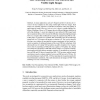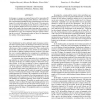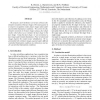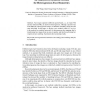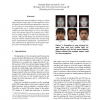107
Voted
ICB
2007
Springer
15 years 7 months ago
2007
Springer
Abstract. In many applications, such as E-Passport and driver’s license, the enrollment of face templates is done using visible light (VIS) face images. Such images are normally ...
134
click to vote
ICMCS
2007
IEEE
15 years 7 months ago
2007
IEEE
In this paper, we propose an original framework for representing 2D and 3D face information using geodesic distances. This aims to define a representation enabling the direct com...
115
click to vote
ICPR
2008
IEEE
15 years 7 months ago
2008
IEEE
Traditional face superresolution methods treat face images as 1D vectors and apply PCA on the set of these 1D vectors to learn the face subspace. Zhang et al [7] proposed Two-dire...
ICPR
2008
IEEE
15 years 7 months ago
2008
IEEE
Recent studies in patch-based Gaussian Mixture Model (GMM) approaches for face age estimation present promising results. We propose using a hidden Markov model (HMM) supervector t...
94
Voted
FGR
2008
IEEE
15 years 7 months ago
2008
IEEE
We propose a novel method to correct for arbitrary illumination variation in the face images. The main purpose is to improve recognition results of face images taken under uncontr...
100
click to vote
AINA
2008
IEEE
15 years 7 months ago
2008
IEEE
We propose a system which extracts faces and person names from news articles with photos on the Web and associates them automatically. The system detects face images in news photo...
112
click to vote
MM
2009
ACM
15 years 7 months ago
2009
ACM
The main difficulty in face image modeling is to decompose those semantic factors contributing to the formation of the face images, such as identity, illumination and pose. One p...
ICB
2009
Springer
15 years 7 months ago
2009
Springer
Face images captured in different spectral bands, e.g. , in visual (VIS) and near infrared (NIR), are said to be heterogeneous. Although a person’s face looks different in hetero...
ACCV
2009
Springer
15 years 7 months ago
2009
Springer
This paper presents a new approach to synthesize face images under different pose changes given a single input image. The approach
111
click to vote
ICPR
2010
IEEE
15 years 8 months ago
2010
IEEE
Matching near-infrared (NIR) face images to visible light (VIS) face images offers a robust approach to face recognition with unconstrained illumination. In this paper we propose ...
